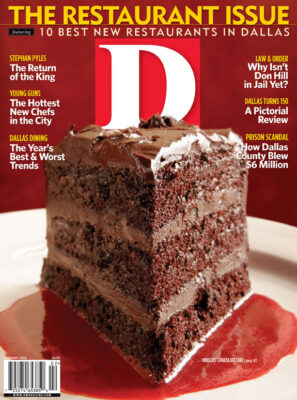 |
| Traffic Light: Henry “Dad” Garrett, known for founding the first municipally owned radio station, WRR, also introduced the city to modern amenities like this traffic light, hanging at the intersection of Pacific Avenue at St. Paul and Live Oak streets, in 1923. Shortly before it was installed, a streetcar made its final trip down Pacific before the tracks were removed. |
Given Dallas’ beleaguered beginnings, it’s no small wonder that the city has survived and thrived as long as it has. Just a few historical notes to consider from the early years:
 |
| Riverboat (above): The 113-foot H.A. Harvey Jr. was the first passenger ship to travel up the Trinity River, arriving from Galveston in 1893 after a voyage lasting two months and 10 days. Here Dallas welcomes the ship with a celebration on the present-day spot of Dealey Plaza. (The river was later rerouted and straightened.) Streetcar (below): Dallas was once part of a 365-mile interurban electric rail network that stretched from Waco to Denison. Additionally, the city itself had a trolley system with more than 120 miles of track. But the automobile did away with all that. The interurbans stopped running in 1948; the trolleys in 1956. Here two off-duty drivers pose with their car in 1913. |
 |
John Neely Bryan, the founder of Dallas, was a squatter. When he settled on the east bank of the Trinity River in the fall of 1841, the land technically belonged to some men in Louisville, Kentucky. The first crop Bryan planted was ruined when a herd of buffalo trampled it. He intended to set up a trading post with the local Indians, but the local Indians were all driven away by forces of the Republic of Texas, so he resorted to ferrying people across the Trinity to make a living.
In 1849, Bryan and every other adult male in Dallas, save one, left to find gold in California. When Bryan didn’t find any, he returned to Dallas, sold off most of his land, and began drinking heavily. He shot another drunk in an argument over his wife, and, mistakenly thinking he’d killed the man, he fled the city and spent a number of years living with Indians, looking for gold mines. He would later slip into madness and die in an Austin sanitarium.
Alexander Cockrell figured to replace Bryan as the town’s visionary leader. He built a grand hotel in Dallas, the city’s first three-story structure. He also built a toll bridge over the Trinity. Then, in 1858, he was killed in a duel by the city marshal, Andrew Moore. The weekly Dallas Herald noted: “Eight shots from Moore’s gun took effect on the deceased, most of them in the lower portion of the abdomen.”
Two years later, at around 1:30 on a July afternoon when the temperature reached 104, the entire city burned to the ground.
Somehow, in the midst of all that Deadwood-style frontier unruliness, Dallas became a real town. On February 2, 1860, the Texas Legislature approved a town charter drafted by Dallas Judge Nat Burford. And here we are today, still going strong 150 years later, still overcoming that Deadwood-style frontier unruliness. If John Neely Bryan were alive today, and if he weren’t insane, he’d be proud.
Research by Michael Darling and Jessica Jones. Special thanks to John Slate, with the City Secretary’s Office; Betty Artis, with the Park and Recreation Department; and Beth Andresen, with the Dallas Public Library.
 |
Biplane: Stunt pilot Otto Brodie, 23, had only a year of flight experience when he arrived in Fair Park for a three-day exposition in 1910. He was the first man to fly a plane in Dallas, a 26-foot, 400-pound Herring-Curtis. Here he is surrounded by admirers. |
 |
Flood: On May 26, 1908, the Trinity River rose to 52.6 feet and expanded to 1.5 miles wide, covering McKinney Avenue with 12 feet of water. The flood killed 11, caused $2.5 million worth of damage, and left almost all of Dallas unreachable by phone, telegraph, and rail for three days. Here a train crosses Turtle Creek on the MK&T line, now the Katy Trail. |
 |
| Tornado: The 1957 tornado killed 10 people, left a 16-mile path of devastation, and caused more than $4 million in damages. |
 |
| Drought: For 52 days in 1953, temperatures rose above 100 degrees, drying up White Rock Lake and reducing even Lake Dallas to only 11 percent capacity. Here a man looks on, waiting for relief from one of the longest droughts in Dallas’ history. |
 |
| State Fair: Big Tex was originally commissioned as the world’s largest Santa Claus by the Kerens Chamber of Commerce. State Fair president R.L. Thornton bought the unpopular holiday relic for $750 and instructed Dallas artist Jack Bridges to give him a facelift. But the pre-op Tex made his debut at the 1952 fair. |
 |
| Elm Street: A serial western starring Tom Mix was always a valid excuse for a boys’ night out. These men lined up outside the Crystal Theater on Elm Street are awaiting the start of the 1919 blockbuster Hell-Roarin’ Reform. |
 |
| Boat Race: Throughout the ’30s and ’40s, boat races like these were a popular form of weekend recreation at White Rock Lake. Thousands parked their cars at T.P. Hill on the weekends to swim, sunbathe, watch the races, and enjoy the occasional fireworks display. |
 |
Parade: The Confederate Reunion Parade was held in Dallas in 1925. Here people await the action at Main and Ervay streets. |
|
Main Street: By 1951, Main Street had solidified its place as the major thoroughfare for downtown traffic. Trains, automobiles, and pedestrians compete for space in a dizzying blur of activity on an otherwise regular afternoon in Dallas. |
Get our weekly recap
Related Articles

What We Saw, What It Felt Like: Stars-Golden Knights, Game 1

A Rollicking DIFF Preview With James Faust




